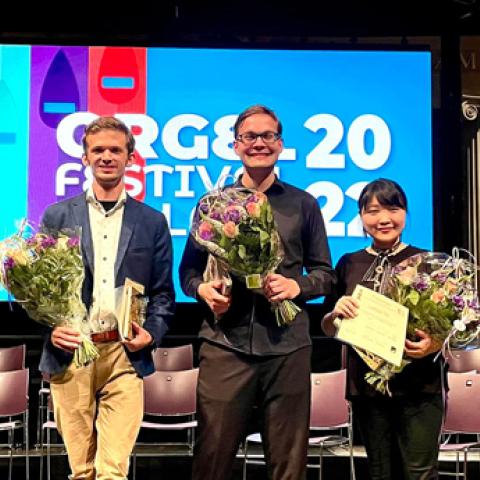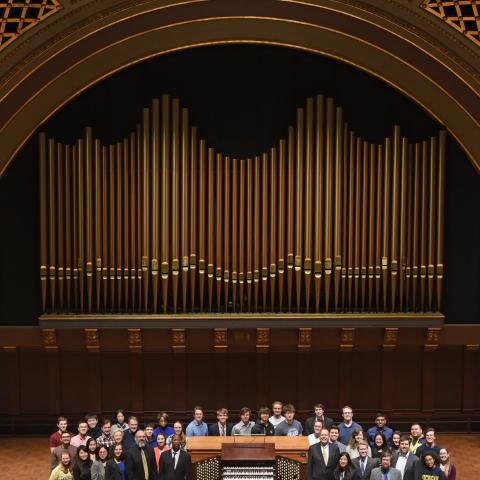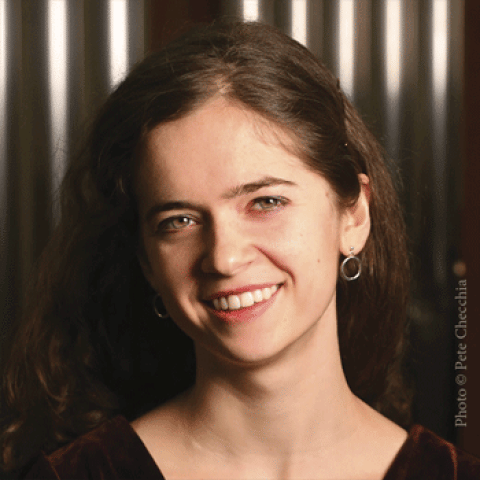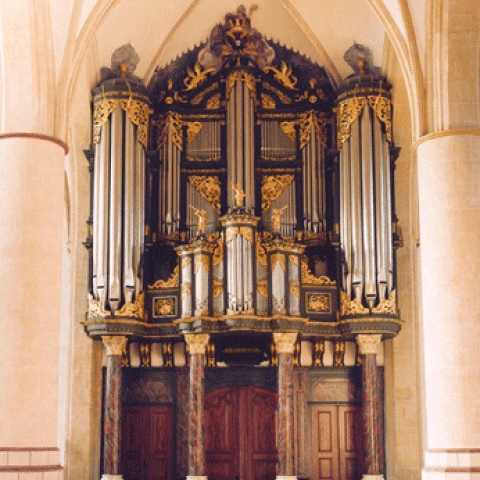Lorraine Brugh is professor of music and Kruse Organ Fellow at Valparaiso University, Valparaiso, Indiana. She recently served as director of the university’s study abroad program in Cambridge, England.

Saturday is market day in Alkmaar. On the way to the Sint-Laurenskerk from my hotel there were stalls filled with fresh fish, cheese, fruits and vegetables, breads and desserts. Tempting as they were, I hurried through to make the 9:00 a.m. starting time for the first round of the International Schnitger Organ Competition 2019. With the church bells chiming 9:00, the jury entered, and the members were introduced.
The jury
The five jury members for 2019 included: Martin Böcker, lecturer at the Hochschule für Musik und Theater Hamburg and artistic director of the Orgelakademie Stade, Germany; Bernard Foccroulle, professor of organ for the Conservatoire of Brussels, Belgium; Krzysztof Urbaniak, head of the organ and sacred music department, Bacewicz Academy of Music in Łódź, Poland; Bas de Vroome, organ professor at the Rotterdam Conservatorium voor Muziek, the Netherlands; and Wolfgang Zerer, professor of organ at the University of Music and Performing Arts in Hamburg, Germany. The competition began in 1991 and is held biennially in Alkmaar, centered at the Great Sint-Laurenskerk in the city center.
The organs
Great Sint-Laurenskerk houses two important organs. The instrument that has already won the grand prize, of course, is the large Germer Van Hagerbeer/Schnitger organ (1646/1725) at the west end, both a sight to behold and a delight to hear. Adding to its appeal is the controversy surrounding its history, which has only served to heighten its prominence. Arp Schnitger died before working on the instrument and his son, Frans Caspar Schnitger, finished the instrument.
The second and smaller instrument is in a swallow’s nest gallery on a side wall of the nave just east of the apse and was built by Jan Van Covelens in 1511. Meantone temperament tweaked this Western equal-temperament ear with unusual tonalities and pitches. Hearing the older music of Sweelinck, Frescobaldi, Hassler, and others offered a glimpse into the way this music originally sounded. The Van Covelens organ is the oldest playable instrument in the Netherlands.
The competition
Forty-five applicants from thirteen countries submitted an audio performance to be considered for the 2019 biennial competition. From those ten were chosen to compete in Alkmaar. To prepare for the competition and its organs, the ten finalists were all given a spring weekend in Alkmaar practicing on the instruments. This gave the competitors time to adjust to the mechanical demands of each instrument and their differences as well as conceive registrations before the competition week.
During the first round each contestant performed on both instruments. As we moved from the apse to the west end the performer also moved from the Van Covelens organ to the Schnitger. Pieter Van Dijk, city organist in Alkmaar, explained the differences of the two instruments from the performers’ point of view: the Van Covelens has a smaller manual compass, limited pedal range, and smaller keys and pedals than the Schnitger. The oldest stop, from 1511, is the Hoofdwerk 6′ Holpijp, which starts at low F. The Trompet in the Pedaal (this division’s only stop) balances perfectly with the 8′ Doof (Praestant) in the manual, though it sounds very loud from the console. The Borstwerk and the Hoofdwerk were both used with a 4′ stop as the foundation in one performer’s final Sweelinck variation. There are almost no repeats in the Mixtuur. The Scherp is intentionally weighted to give the top intensity, just as choirs are often weighted with more sound in the treble than in the bass registers.
The Schnitger organ fills the entire west end of the nave, a beautiful and massive case. In 1725 Schnitger added a 2′ flute in the Groot-Manuaal and the 2′ Nachthorn in the Pedaal, adding a brighter and singing quality to the instrument. Schnitger added these at his own expense as he felt the organ was incomplete without them.
A large part of the competition’s challenge lies in transitioning from one instrument to the other in the space of a few minutes. The pieces in this round were all compulsory: Sweelinck, Erbarm dich mein, O Herre Gott, SwWV 30, on the Van Covelens organ, and Bach, Allein Gott in der Höh sei Ehr, BWV 664, and Prelude and Fugue in C Major, BWV 547, on the Schnitger.
There was no memorization requirement for the competition, and competitors were known to the jury and audience only by their contestant number. So, while the playing level was generally strong, musically and technically, there was no way to know who was playing during their performance. Listening became an exercise in hearing subtle differences between interpretations of a piece, considering various tempi, and listening to how performers used the room and its acoustics.
Following the ten performances, the six finalists to advance to the second round were Victor Manuel Baena de la Torre (Spain), Oliver Brett (United Kingdom), Freddie James (United Kingdom), António Pedrosa (Portugal), Daniel Seeger (Germany), and Vittorio Vanini (Italy).
The next round offered some choice in literature, this time played on the Kapelkerk organ in Alkmaar. The organ is a Christian Müller instrument from 1762, maintained by Flentrop since 1939 and restored by the firm between 1982 and 1986. The repertoire included a Buxtehude canzona of the player’s choice, three chorale preludes for manuals alone from J. S. Bach’s Clavierübung III (Wir glauben all in einen Gott, BWV 681, Allein Gott in der Höh sei Ehr, BWV 677, and Die sind die heilgen zehn Gebot, BWV 679), and a Bach toccata for manuals alone (BWV 910–916). A hot summer evening did not make playing these delicate pieces any easier. The jury selected Victor Baena de la Torre, Freddie James, and Vittoria Vanini as the three finalists for 2019.
The finalists
Victor Baena de la Torre (Spain, b. 1995): At the age of twelve de la Torre started playing guitar and piano and later studied these instruments at the Conservatory of Madrid. There he became interested in the interpretation of early music, especially for organ and harpsichord, and decided to study organ with Anselmo Serna and harpsichord and basso continuo with Denise De La-Herrán. As a basso continuo player, he has participated in various opera productions. He has participated in masterclasses for organ and harpsichord with, among others, Lorenzo Ghielmi and Bernard Foccroulle. He currently studies at the Conservatory of Amsterdam with Pieter van Dijk and Matthias Havinga.
Freddie James (United Kingdom, b. 1990): James started as a chorister at Southwark Cathedral, and after leaving the choir, he held positions as organ scholar at Croydon Minster and assistant organist at Sint-Nicolaas Basilica, Amsterdam. He was then organ scholar at St John’s College, Cambridge. With the choir, he performed in a range of venues around the world, including in Japan (Suntory Hall, Tokyo, Tokyo Opera City), the United States, Germany, the Netherlands, and Denmark, and on a number of radio broadcasts, including a recording for Chandos of works by Thomas Tomkins. He was subsequently organist of the Christuskirche, Stuttgart, and is currently organist of the Church of St. Peter and Paul, Oberwil, in Basel, Switzerland.
Vittorio Vanini (Italy, b. 1996): Vanini entered the Conservatorio of Como, Italy, in 2011, where he studied first with Luca Bassetto, then with Enrico Viccardi. In 2017 he completed a bachelor’s degree in organ with honor. During his studies he focused on organ literature, harpsichord, and thorough-bass with Davide Pozzi and on composition with Antonio Eros Negri and Caterina Calderoni. He is currently studying at the Schola Cantorum Basiliensis, Switzerland, in the class of Tobias Lindner. He has been working as a church organist in the parishes of Lurago Marinone and Cucciago, Italy, and he has given concerts in Italy, Germany, and Switzerland.
The final round
The final round returned to Sint-Laurenkerk with literature for both organs. For the Van Covelens organ, each contestant chose a song variation set by Sweelinck. On the Schnitger organ each finalist chose a large Bach chorale prelude from Clavierübung III or from 18 Choräle verschiedener Art and a prelude and fugue [BWV 532, 541, 546, or 550], and a work by Piet Kee from Gedenck-Clanck ’76.
The winners and prizes
The prizes reflect both the civic and religious relationships of this festival to the city of Alkmaar. Following the final round the jury announced the prizes:
Schnitger prize (first prize, €5,000)—Victor Baena de la Torre
The first prize of the competition is named after organbuilder Frans Caspar Schnitger (1693–1729), son of the legendary Arp Schnitger. In 1723–1725, at the instigation of the newly appointed city organist Gerhardus Havingha (1696–1753), Frans Caspar carried out the highly controversial renovation of the Van Hagerbeer organ in Alkmaar. Behind the unchanged organ cases, designed by architect Jacob van Campen, a completely new type of instrument in North German style arose for Holland. Schnitger thus achieved the definitive breakthrough of this aesthetic in Dutch organbuilding. The Alkmaar organ is the best-preserved instrument by him.
Flentrop prize (second prize, €2,500)—Vittorio Vanini
Flentrop Orgelbouw of Zaandam, the Netherlands, has executed many important organ restoration and new-build projects in the Netherlands and abroad, including the restoration of both organs in Grote Sint-Laurenskerk, Alkmaar. Flentrop Orgelbouw adopted the second prize of the International Schnitger Organ Competition during the tenure of Cees van Oostenbrugge, who was then the company’s director.
Third prize (€1,000)—Freddie James
Izaäk Kingma prize (audience prize)—Vittorio Vanini
Izaäk Kingma (1936–2004) was secretary of both Alkmaar organ foundations for many years: the International Schnitger Organ Competition Foundation and the Friends of the Organ Foundation. In addition to his career in education, he was active as an organist in various churches in Alkmaar, including the Trefpuntkerk and the Remonstrantse Kerk. Because of its great merits for the Alkmaar organ culture, the International Schnitger Organ Competition Foundation decided in 2004 to link its name to the public prize of the International Schnitger Organ Competition that takes place during the biennial Organ Festival Holland in Alkmaar.
The symposium
Running concurrently with the competition was an organ symposium, a series of workshops and masterclasses presented by the jury members. This year’s topic was “The better Schnitger?” The young organbuilder Frans Caspar Schnitger, son of the legendary Arp Schnitger, with his organ in Alkmaar, was the subject of the symposium. Workshops and masterclasses were offered for “accomplished amateur and professional organists.” Participants who wished to play for the masterclasses also prepared required pieces for the event.
The presentations included:
Martin Böcker: “Schnitger in Stade and Hamburg and what happens before and afterwards.” This presentation looked at the ways Arp Schnitger developed his premise for sound ideal and construction close to home before building instruments further afield;
Cees van der Poel: “The Zwolle Organ—Schnitger’s Ticket to Holland.” This commission began Arp Schnitger’s international career, opening the way to further projects in the Netherlands;
Krzysztof Urbaniak: “Activity of Schnitger’s pupils east of the Oder-Neisse line.” Dr. Urbaniak demonstrated the direct influence of the Schnitger style on Polish instruments through the students and apprentices of Arp Schnitger;
Gerben Gritter, professor of music theory and organbuilding at the Amsterdam University of the Arts. His doctoral thesis focused on the life and work of the organbuilder Christian Müller, the builder of the Sint-Bavokerk organ in Haarlem. He highlighted differences and similarities between Schnitger and Müller;
Frank van Wijk, organist at the Kapelkerk in Alkmaar: “The innovative properties that the Alkmaar organ still has to offer us today.” VanWijk described many of the events that keep the church and its organs in the center of the city’s life. Hosting children’s choir festivals, organ recitals, and other innovative programming keeps the community connected to this landmark church. The foundation that supports the festival brings guest performers and new music for these old organs in order to reach a new audience. Specific composition commissions and combinations of organ with choir, orchestra, or electronics are used to broaden the organ culture.
Concert and recital highlights
The festival included an organ and choral concert featuring the St. Salvator Chapel Choir, St. Andrew’s University, Edinburgh, Scotland, Claire Innes-Hopkins, director, and Bernard Foccroulle, organist. The Scottish choir delighted the audience with its sleek sound in a beautiful acoustic. The Schnitger organ created an interesting dialogue with its massive and varied sounds.
A noonday concert presented Cees van der Poel and Gerben Gritter playing works of Lübeck, Böhm, Jacob Wilhelm Lustig, and Johann Nikolaus Hanff on the Schnitger organ. A “Four hands and feet organ concert” put the spotlight on Pieter Van Dijk, city organist in Alkmaar, and Frank Van Wijk, playing solo and duet literature.
This is an ambitious festival, carried out by an army of volunteers. The festival committee created a hospitable welcome while running a well-planned, high-level event. Gratitude is due to all those who work hard to keep this instrument and its importance alive, giving pride of place to young organists ready to build their performance careers.






